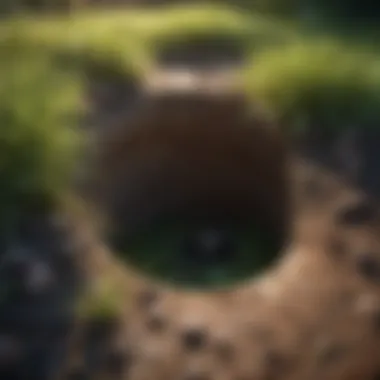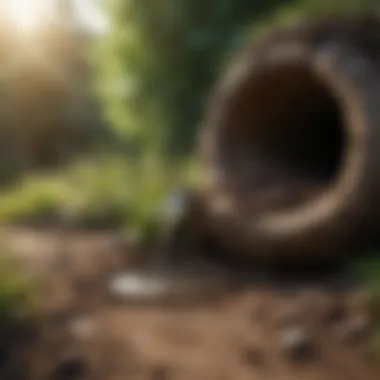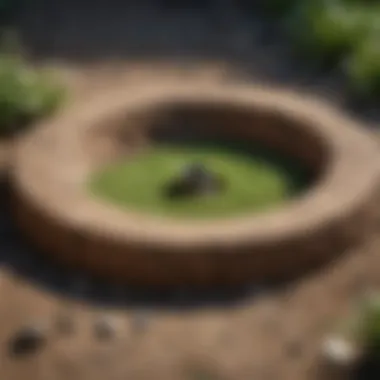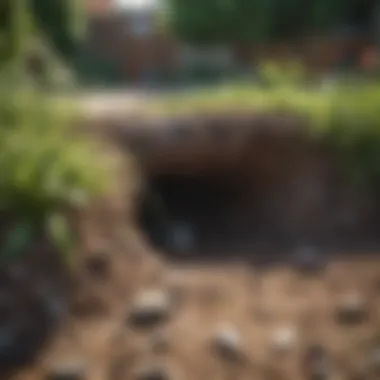Mastering the Art of Filling Holes in Your Yard


Intro
Filling a hole in your yard might seem like a simple task, but there is much more to consider than just tossing some dirt into the gap. Understanding the nature of the hole, the underlying soil composition, and the materials needed for effective repair can significantly impact the success of the project. Yard holes can arise from various causes, including erosion, animal activity, or even the settling of soil over time. This comprehensive guide aims to cover all aspects of hole repair, providing valuable insights for homeowners and garden enthusiasts.
Understanding Yard Holes
Different Types of Holes
Holes in yards can vary significantly in size and cause. They can range from small dips created by settling earth to larger craters caused by animal burrowing or drainage issues. Some common types of holes include:
- Animal Burrows: Created by rodents or other wildlife that dig beneath the surface, often leading to larger voids.
- Erosion: Typically found in areas where water runoff is prevalent, causing the soil to wash away.
- Settling Soil: Over time, soil can compact and settle, leading to sunken areas in your yard.
Causes of Yard Holes
Understanding the cause of the holes is crucial for effectively addressing them and preventing future occurrences. Here are some common causes:
- Heavy rainfall leading to erosion.
- Pests like moles or voles making their homes underground.
- Poor soil compaction during landscaping.
- Tree roots decaying and leaving voids.
Importance of Repairing Holes
Addressing yard holes is not only an aesthetic concern but also vital for maintaining the health of your landscape. Unattended holes can lead to:
- Water pooling, increasing the risk of pest infestations.
- Damaging your lawnmower or garden equipment.
- Creating tripping hazards for family or guests.
Materials for Filling Holes
Selecting the right materials is key to ensuring a durable repair. Depending on the nature of the hole, you might consider:
- Topsoil: Ideal for filling shallow holes and promoting grass growth.
- Gravel: Useful for larger holes, especially in drainage areas.
- Sand: Best for enhancing drainage in softer soil but must be used carefully.
It is important to research the soil type in your yard to choose materials that will blend well and support stability after filling.
Step-by-Step Instructions
Preparing the Area
Before filling, assess the hole and surrounding area:
- Clear any debris or loose soil around the hole.
- Determine if the hole requires additional drainage to prevent future issues.
- If you find any loose soil or roots, remove them carefully.
Filling the Hole
- Begin by adding a layer of gravel at the bottom of larger holes if drainage is an issue.
- For smaller holes, start with topsoil. Add the material gradually, tamping it down to avoid settling later.
- Ensure the filled hole is slightly higher than the surrounding area, as the soil will settle over time.
Final Touches
- Once the hole is filled, reseed with grass if needed or lay sod to promote recovery.
- Water the area lightly to aid soil compaction and promote growth.
Maintenance Considerations
Post-filling, maintaining your yard is crucial. Regularly monitor the filled area for signs of sinking or poor drainage. Ensure that water is flowing appropriately away from the area to prevent future erosion.
Additionally, consider using preventive measures like proper soil compaction and installing drainage systems in susceptible areas.
By understanding the various aspects of yard hole repair, you'll ensure that your yard remains in optimal condition, enhancing its aesthetics and usability.
Understanding the Types of Holes in Your Yard


Understanding the types of holes in your yard is a crucial first step towards effective maintenance. Each kind of hole presents unique challenges and requires tailored approaches for filling. By identifying the root cause, homeowners can prevent similar issues in the future and maintain a healthy landscape. Recognizing what’s causing the holes will save time and resources and enhance the overall aesthetic of your yard.
Natural Ground Settling
Natural ground settling occurs when soil compresses over time. Factors like heavy rains and temperature changes can lead to this phenomenon. As the ground settles, it can create depressions that homeowners may mistake for larger issues. The risk lies in ignoring small shifts, which could compound over time, creating bigger holes. Being aware of natural ground settling allows you to monitor your soil condition and act before the problem escalates.
Animal Activity
Various animals can disrupt the ground in your yard. Burrowing creatures like moles or gophers can create holes as they dig tunnels beneath the surface. Even insects, like ants, can contribute to surface disruptions. It’s important to not only recognize these signs but also understand wildlife patterns. Observing these animals can provide insights into when and where repairs are most necessary.
Water Erosion
Water erosion is caused by the continuous flow of water, which can gradually wear away soil, creating holes. This is particularly common in regions with heavy rainfall or poor drainage systems. The erosion can lead to significant landscape damage if left untreated. Homeowners can mitigate water erosion through proper landscaping and drainage improvements, safeguarding their yards from future issues.
Construction and Maintenance Issues
Construction projects can seem complete, yet often leave behind unintended consequences. Heavy machinery can compact or displace soil, leading to holes as the soil settles post-construction. Similarly, maintenance activities, like landscaping or gardening, can cause disruption. Being mindful of these actions can help in identifying the source of holes and determining the necessary steps for resolving the issue.
Understanding the types of holes in your yard is essential for effective maintenance and long-term yard health.
Identifying the Cause of the Hole
Identifying the cause of the hole in your yard is a critical preliminary step in addressing the issue effectively. Holes may stem from various origins, and understanding the reasons behind their formation helps in selecting the right repair method and preventing future occurrences. A lack of insight into the cause could lead to temporary fixes that do not resolve the underlying issues.
Assessing Soil Condition
Assessing the soil condition aids in diagnosing why a hole has developed. This step involves examining the soil's composition, moisture level, and compaction. Soil can settle naturally over time, especially in areas with clay or sandy materials. Loose, unstable soil is especially prone to creating small depressions. You should take a handful of soil and check its texture. If it clumps together, the moisture may be too high, leading to erosion or settling. On the contrary, dry and loose soil can indicate drainage issues.
A systematic approach involves:
- Checking for water pooling after rain, which signals poor drainage.
- Observing whether certain plants appear unhealthy, indicating potential root problems or insufficient nutrients.
- Testing the pH and nutrient levels in the soil, as imbalances can contribute to growth issues that may also present as holes.
Observing Wildlife Patterns
Wildlife can be a significant factor in the creation of holes in your yard. Various animals dig or burrow and, in the process, may leave behind pits that affect the landscape. Observing the activity patterns of local wildlife can provide insights into what may be causing the holes.
For example, moles and voles are common culprits. They create tunnels and surface holes as part of their foraging behavior. To determine whether wildlife is responsible, look for signs like:
- Freshly dug soil or disturbed areas
- Tracks or trails indicating animal movement
- Burrows or dens nearby
Pay close attention during different times of the day, as many animals are more active at dawn or dusk. In addition, nocturnal animals may leave traces of their activity that are easier to spot at night. By comprehensively studying the wildlife interactions in your yard, you can take appropriate measures to manage their impact on your landscape.
Gathering Necessary Materials
Gathering the right materials is a crucial phase in filling a hole in your yard. The materials directly influence the effectiveness of the repair. Without appropriate options, the hole may return or worsen with time. Therefore, having a clear understanding of what is needed can make the process smoother and more efficient.
Topsoil and Fill Dirt
Topsoil is the uppermost layer of soil, which is rich in nutrients. It is essential when filling holes for several reasons. First, it promotes healthy plant growth. When filling a hole, using topsoil rather than just any dirt helps support future grass or plants. Second, it helps in drainage. The right texture of topsoil can facilitate water movement, preventing water from stagnating in the filled area.
Fill dirt, on the other hand, is necessary for establishing a solid foundation. It compacts well and fills larger voids effectively. Intermixing topsoil with fill dirt can enhance stability and provide a nutrient-rich top layer. As you choose your fill materials, consideration should be given to the composition and source. Local landscape suppliers often offer a blend that suits your region’s climate condition.
Compacting Tools
Compacting tools are vital for ensuring that the filled area is stable. The goal of compaction is to eliminate air pockets and densify the soil. This process reduces the potential for settling, which can lead the filled hole to reopen or sink further over time. Common tools include mechanical tampers, hand tampers, and occasionally, even water-filled rollers for larger jobs.
When choosing a tool, consider the size of the hole and the available space for maneuvering. A smaller manual tamper can be effective for smaller holes while a mechanical option speeds up the compaction for bigger repairs. Furthermore, ensure that the tool is in good condition. Damaged tools may lead to inadequate compaction and unresolved issues in the future.
Watering Equipment


Watering is often an overlooked step but is significant in the process of filling a hole. Properly moistening the area after filling can help in settling the soil. Watering aids in the compaction process, promotes healthy drainage, and helps plant roots establish as the soil settles.
The choice of watering equipment does not have to be complex. A basic garden hose with a spray nozzle works for smaller areas, while a sprinkler system can be efficient for larger patches. Be careful not to overwater, as too much water can lead to erosion or further settling. Observe how the ground absorbs water, adjusting as necessary to keep the area stable.
Step-by-Step Process to Fill the Hole
Filling a hole in your yard is not merely an aesthetic choice. It can significantly affect the health and stability of your landscape. Addressing holes properly ensures that the integrity of the soil is maintained, preventing further erosion and providing a stable base for vegetation. In this section, we will explore the essential steps involved in the filling process, highlighting the importance of each task.
Excavation Preparation
Before starting the filling process, it is crucial to prepare the excavation site. Begin by clearing the hole of any debris, rocks, or loose soil. This step is vital, as it allows for better adhesion of the fill materials; any foreign objects can interfere with compaction later on. Assess the depth and width of the hole to determine the right amount of fill needed. Having the correct measurements helps prevent over or under-filling, which could lead to problems down the line. Make sure to outline a clean edge around the hole. This practice contributes to a more even fill and supports stability.
Filling the Hole
Once preparation is complete, it's time to fill the hole with suitable material. Use a combination of topsoil and fill dirt to achieve the best results. Fill dirt is typically denser, while topsoil provides nutrients for any grass or plant life you may desire. Start by layering the fill material evenly. Avoid dumping in one large scoop, as it can create air pockets which lead to settling over time. Instead, add small amounts and work systematically. This method ensures even distribution and aids in effective compaction.
Compacting the Fill
Compaction is an essential step. It solidifies the fill material, preventing future sinking or settling. Use a hand compactor or a mechanical compactor if available. Compact the fill in layers, ideally no thicker than six inches, to achieve optimal results. After each layer, give it a good tamping down. Test the firmness after each compaction; the fill should not give much when pressed. Proper compaction can mean the difference between a successful filling job and an unsightly hole reappearing.
Final Grading and Leveling
The next step involves grading the area around the filled hole. Final grading ensures that the surface is level with the surrounding yard. Use a rake to achieve this uniformity. Gradually slope the area around the hole to facilitate proper drainage away from the yard. Any pooling of water can lead to erosion, and thus avoiding this is crucial for the longevity of your landscape. A smooth, even surface will not only look more appealing but also provide a stable space for any future grass or plants to grow.
Watering the Area
Watering your filled hole is a critical but often overlooked step. Initially, moisten the fill material lightly as you finish. This process helps the soil settle and compact more effectively. Ensure not to overwater; excessive moisture can cause the fill to wash away or erode, negating your hard work. For prolonged success, watering the area regularly as it establishes can promote stronger plant growth if you decide to plant grass or other vegetation.
Regular monitoring and appropriate watering can mean a lush lawn over time.
With these straightforward steps, anyone can successfully fill a hole in their yard. By taking the time to prepare, fill, compact, grade, and water, the outcome will be not only visually pleasing but also sustainable in the long run.
Post-Filling Maintenance
After filling a hole in your yard, it is crucial to implement a solid maintenance strategy. Maintaining the area not only ensures the fill settles properly but also encourages healthy growth of plants, including grass, thereby integrating it seamlessly with the surrounding landscape. Poor post-filling care can lead to future problems, such as sinkholes or inappropriate water drainage.
Monitoring the Site
Monitoring the filled site is essential for a successful outcome. Regular checks can help you notice any shifting or settling issues early on. Look for signs like uneven ground or surface depressions. It’s important to walk the area periodically, especially after heavy rain or watering. These factors can influence how well the fill material stays in place.
Here are some key things to monitor:
- Surface level: Ensure that the filled area is level with the surrounding ground.
- Cracking or squeezing: Watch for cracks or signs that the fill material is compacting too much.
- Soil moisture: Keep an eye on moisture levels. Too much water can cause erosion, while too little can hinder plant growth.
By actively monitoring your site, you can maintain its stability and prevent future issues. Regular inspections should be a part of your yard care routine.
Applying Grass Seed
Once you have monitored the filled hole and ensured its stability, applying grass seed can significantly enhance the aesthetic appeal and ecological health of your yard. Grass serves multiple roles, such as preventing erosion and providing habitat for native wildlife.
When selecting grass seed, consider the following factors:
- Local climate: Choose a seed that thrives in your area’s specific climate conditions.
- Soil type: Understand the characteristics of your soil as some seeds perform better in sandy soils while others prefer clay.
- Sun exposure: Determine how much sunlight the area receives daily to select the right type of grass.
The process of applying grass seed involves several important steps:
- Preparation: Rake the fill area gently to create a seedbed. This helps the seeds make good contact with the soil.
- Seeding: Spread the grass seeds evenly across the designated area. Use a seed spreader for more uniform application.
- Watering: Lightly water the area after seeding. Keep the soil adequately moist during the germination period. Avoid overwatering, which can lead to washout or seed displacement.
- Protection: Consider applying a light layer of straw to protect the seeds from birds and prevent soil erosion.
In summary, effective post-filling maintenance involves consistent site monitoring and the careful application of grass seed. Both these steps contribute to a stable and flourishing yard environment.


Preventing Future Holes
Preventing future holes in your yard is essential for maintaining a well-kept outdoor space. Understanding the underlying factors that contribute to these depressions can help you develop effective strategies. Regular upkeep not only enhances the aesthetic appeal of your property but also safeguards against environmental issues that can compromise soil integrity.
A few essential benefits accompany a proactive approach to yard maintenance. Firstly, it minimizes the risk of further erosion or animal activity that might create new holes. Secondly, by paying attention to your yard's ecosystem, you can avoid problems arising from natural settling or poor drainage. Finally, a well-maintained yard encourages healthy plant growth and prevents soil compaction, which can lead to long-term issues.
Regular Yard Maintenance Tips
Regular yard maintenance is a keystone in preventing holes from forming. Here are some practical tips:
- Aerate Your Soil: Aeration enhances soil health by allowing oxygen to penetrate deeper, promoting robust root growth. Consider doing this at least once a year, especially in high-traffic areas.
- Monitor Moisture Levels: Overwatering can contribute to soil erosion, while under-watering can lead to settling. Ensure a balanced watering schedule according to weather conditions.
- Fertilize Appropriately: Balanced fertilization helps maintain soil structure. Use organic fertilizers, as they improve the natural composition of the soil over time.
- Keep Debris Off the Lawn: Regularly remove leaves, branches, and other debris. This not only keeps your yard looking neat but keeps the soil from becoming compacted beneath the weight of organic matter.
- Check Drainages: Ensure that your yard's drainage systems, such as gutters and downspouts, are functioning correctly to avoid localized flooding.
These practices can go a long way in maintaining the stability of your lawn and preventing the formation of new holes. Consistency is key.
Observing Wildlife Interactions
Understanding the role of wildlife in your yard will help you anticipate and mitigate potential issues. Observing wildlife interactions allows you to take necessary precautions against animal activity that could disturb the soil.
For instance, if you notice burrowing animals like moles or rabbits in your yard, you may want to explore humane repellents or barriers to keep them at bay. Failing to observe these interactions could result in multiple holes and disruptions.
Consider the following:
- Identify Problematic Species: Take note of wildlife that frequents your yard. Each species interacts differently with the environment.
- Monitor Activity Patterns: Timing is critical. Certain animals are more active during specific seasons, which could influence your yard maintenance strategies.
- Implement Preventive Measures: If you begin to see signs of wildlife disturbances, consider installing fencing or using deterrent plants to keep them from settling in.
When to Seek Professional Help
When dealing with a hole in your yard, it can be tempting to take a do-it-yourself approach. However, there are certain situations where calling a professional becomes a necessity. Understanding when to seek help can save you time, money, and further complications.
Assessing the damage is crucial. Holes that appear unexpectedly can be indicators of underlying issues. Soil instability, substantial erosion, or even drainage problems may require the expertise of a professional. Ignoring these signs can lead to greater problems down the line.
Assessing the Extent of Damage
Before deciding to engage professional assistance, evaluate the size of the hole and the surrounding conditions. A small hole, perhaps caused by animal activity or natural settling, might be manageable on your own. However, if the diameter exceeds two feet or if the hole is deep, consider professional help.
Here are some indicators to consider:
- Unusual soil movement or shifting in adjacent areas.
- Formation of multiple holes across your yard.
- Presence of water pooling near the hole.
These can signal more severe issues that require specialized examination.
Identifying Special Conditions
Specific situations warrant professional assessment. If you are pursuing landscaping changes or digging deeper holes for planting, you should evaluate potential utility lines or drainage systems. Unforeseen underground obstacles can not only damage your property but could also pose safety risks.
Conditions to look for include:
- Proximity to electrical or water lines, often marked by flags.
- Signs of foundation problems in your home.
- Soil that appears to wash away frequently or recurs as a problem area.
In instances where structural evidences align with your yard predicament, professionals can conduct comprehensive assessments. Engaging experts can clear confusion and provide solutions that align with best practices. So, knowing when to call for help can lead to better yard health and safety in the long run.
It's always better to be safe than sorry. If you suspect there's a bigger issue at play, a professional's insights can save you from costly mistakes.
Epilogue
Filling a hole in your yard is not merely a cosmetic endeavor; rather, it has significant implications for both the health of your landscape and the usability of your outdoor space. This article has delved into the various types of holes, the underlying causes behind them, and the necessary steps to address each situation thoughtfully.
Understanding the causes of yard holes is crucial. For example, recognizing whether natural ground settling or animal activity is responsible can guide your approach. The right materials play a vital role too; utilizing appropriate topsoil or fill dirt ensures long-term stability.
Moreover, the step-by-step process outlined in this guide, from preparation to post-filling maintenance, is designed to foster successful implementation.
Another essential aspect is preventive measures. Regular yard maintenance not only helps to prevent future holes but also contributes to a vibrant and sustainable environment. Dry or overly compacted soil can lead to further settling and burrowing by wildlife; hence, awareness is key.
In circumstances where damage extends beyond simple filling, knowing when to seek professional assistance proves invaluable. It's crucial to assess the extent of any underlying issues that might not be visible at first glance.
Ultimately, maintaining the integrity of your yard enhances both its beauty and functionality. A well-kept yard can provide a respite, serve as a gathering place, and add value to your home. Embracing the methods discussed ensures that your outdoor space remains a source of enjoyment and not a stressor. With thorough understanding and diligent effort, one can achieve not just a level yard, but a thriving landscape for years to come.















